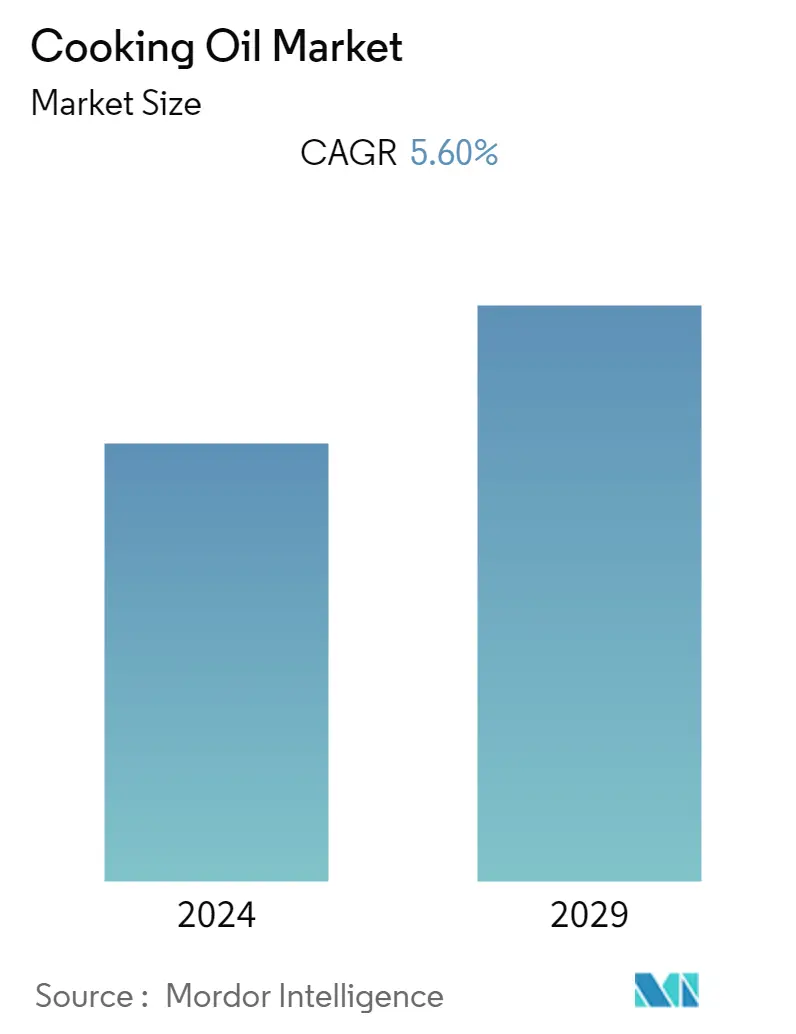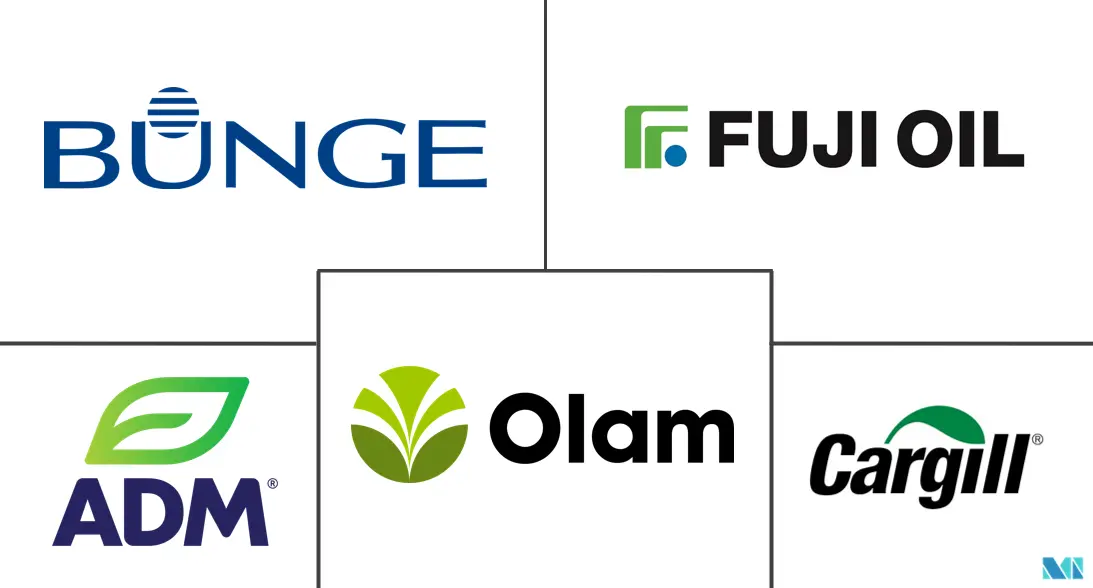Market Size of Cooking Oil Industry

| Study Period | 2018 - 2029 |
| Base Year For Estimation | 2023 |
| CAGR | 5.60 % |
| Fastest Growing Market | Africa |
| Largest Market | Asia-Pacific |
| Market Concentration | Low |
Major Players
*Disclaimer: Major Players sorted in no particular order |
Cooking Oil Market Analysis
The cooking oil market is projected to register a CAGR of 5.6% during the next five years.
The global cooking oil market is driven by the robust demand for organic health-based products, with increased consumption of high-quality edible oils/cooking oils by health-conscious consumers and the growing demand from various applications, such as confectionery, primarily in the production of candies. Also, refined olive oil and coconut oil are increasingly used in various bakery applications, as they are bland in taste, allowing the food to maintain its original flavor. Additionally, they do not exhibit any pungency, unlike mustard oil.
The demand for non-GMO edible oil has also catered to the market, as it augmented the shares of sunflower oil, coconut oil, and olive oil, together with leading segments of the market studied, including palm oil, canola oil, and soybean oil. Palm oil is one of the most highly used vegetable oils. In the past few years, palm oil production amplified significantly, with almost all production growth set in Malaysia and Indonesia. However, the associated large-scale deforestation is restricting palm oil's application in varied food sectors, as consumers are becoming highly aware of the damages caused by deforestation to the environment, and they are opting for the International Palm Oil Free Certification.
Cooking Oil Industry Segmentation
Cooking oil is a liquid fat made of plants, animals, or synthetic materials used in baking, frying, and other cooking processes. It may also be referred to as edible oil because it is used in cold food preparation and flavoring, including salad dressings and bread dips.
The global cooking oil market has been segmented based on type, application, and geography. Based on type, the market studied is segmented into palm oil, rapeseed oil, sunflower oil, peanut oil, and other types. Based on application, the market studied is segmented into bakery and confectionery, snack foods, salads and cooking oils, and other applications. Based on geography, the market studied is segmented into North America, Europe, Asia-Pacific, South America, and Middle East and Africa. For each segment, the market sizing and forecasts have been done based on value (in USD million).
| By Product Type | |
| Palm Oil | |
| Rapeseed Oil | |
| Sunflower Oil | |
| Peanut Oil | |
| Other Types |
| By Application | |
| Bakery and Confectionery | |
| Snack Foods | |
| Salads and Cooking Oils | |
| Margarine, Fillings, and Spreads | |
| Other Applications |
| By Geography | |||||||||
| |||||||||
| |||||||||
| |||||||||
| |||||||||
|
Cooking Oil Market Size Summary
The cooking oil market is experiencing significant growth, driven by the increasing demand for organic and health-based products. Health-conscious consumers are opting for high-quality edible oils, which are also seeing rising demand in various applications such as confectionery and bakery products. Oils like refined olive and coconut are favored for their bland taste, which preserves the original flavor of foods. The market is also witnessing a shift towards non-GMO options, boosting the popularity of sunflower, coconut, and olive oils. Palm oil remains a dominant player due to its cost-effectiveness and extensive use in the food industry, although environmental concerns related to deforestation are influencing consumer choices. The Asia-Pacific region, particularly China, is a major consumer and importer of vegetable oils, driven by a strong population base, health-conscious consumers, and a growing processed food industry.
The global cooking oil market is characterized by fragmentation and competitiveness, with major players like Archer Daniels Midland Company, Bunge Limited, Fuji Oil Group, Cargill Incorporated, and Olam Oil Group holding significant market shares. These companies focus on product innovation and strategic expansions to maintain their market positions. Recent acquisitions, such as Alfa Laval's purchase of Desmet and Cargill's refinery acquisition in India, highlight the industry's trend towards enhancing production capabilities and expanding geographical footprints. Bunge's investment in a new facility in Amsterdam underscores the industry's commitment to offering a diverse range of culinary oils and fats, aligning with the growing consumer demand for sustainably sourced products.
Cooking Oil Market Size - Table of Contents
-
1. MARKET DYNAMICS
-
1.1 Market Drivers
-
1.2 Market Restraints
-
1.3 Porter's Five Forces Analysis
-
1.3.1 Threat of New Entrants
-
1.3.2 Bargaining Power of Buyers/Consumers
-
1.3.3 Bargaining Power of Suppliers
-
1.3.4 Threat of Substitute Products
-
1.3.5 Intensity of Competitive Rivalry
-
-
-
2. MARKET SEGMENTATION
-
2.1 By Product Type
-
2.1.1 Palm Oil
-
2.1.2 Rapeseed Oil
-
2.1.3 Sunflower Oil
-
2.1.4 Peanut Oil
-
2.1.5 Other Types
-
-
2.2 By Application
-
2.2.1 Bakery and Confectionery
-
2.2.2 Snack Foods
-
2.2.3 Salads and Cooking Oils
-
2.2.4 Margarine, Fillings, and Spreads
-
2.2.5 Other Applications
-
-
2.3 By Geography
-
2.3.1 North America
-
2.3.1.1 United States
-
2.3.1.2 Canada
-
2.3.1.3 Mexico
-
2.3.1.4 Rest of North America
-
-
2.3.2 Europe
-
2.3.2.1 United Kingdom
-
2.3.2.2 Germany
-
2.3.2.3 Spain
-
2.3.2.4 France
-
2.3.2.5 Italy
-
2.3.2.6 Russia
-
2.3.2.7 Rest of Europe
-
-
2.3.3 Asia-Pacific
-
2.3.3.1 China
-
2.3.3.2 Japan
-
2.3.3.3 India
-
2.3.3.4 Australia
-
2.3.3.5 Rest of Asia-Pacific
-
-
2.3.4 South America
-
2.3.4.1 Brazil
-
2.3.4.2 Argentina
-
2.3.4.3 Rest of South America
-
-
2.3.5 Middle East and Africa
-
2.3.5.1 Saudi Africa
-
2.3.5.2 Saudi Arabia
-
2.3.5.3 Rest of Middle East and Africa
-
-
-
Cooking Oil Market Size FAQs
What is the current Cooking Oil Market size?
The Cooking Oil Market is projected to register a CAGR of 5.60% during the forecast period (2024-2029)
Who are the key players in Cooking Oil Market?
Archer Daniels Midland Company , Cargill Incorporated , Bunge Limited , Olam Group Limited and Fuji Oil Group are the major companies operating in the Cooking Oil Market.

